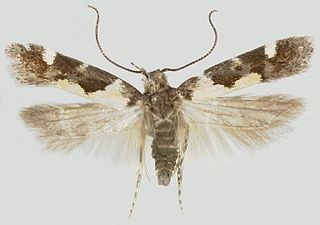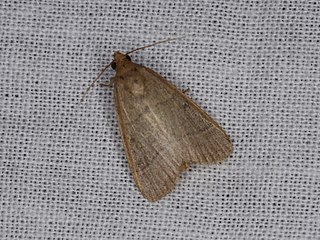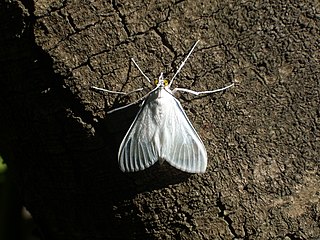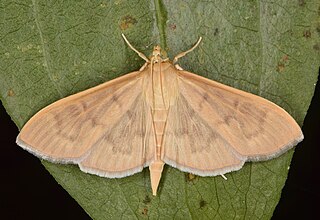
Cornus florida, the flowering dogwood, is a species of flowering tree in the family Cornaceae native to eastern North America and northern Mexico. An endemic population once spanned from southernmost coastal Maine south to northern Florida and west to the Mississippi River. The tree is commonly planted as an ornamental in residential and public areas because of its showy bracts and interesting bark structure.

The Luna moth also known as the American moon moth is a Nearctic moth in the family Saturniidae, subfamily Saturniinae, a group commonly known as giant silk moths. It has lime-green colored wings and a white body. The larvae (caterpillars) are also green. Typically, it has a wingspan of roughly 114 mm (4.5 in), but can exceed 178 mm (7.0 in), making it one of the larger moths in North America. Across Canada, it has one generation per year, with the winged adults appearing in late May or early June, whereas farther south it will have two or even three generations per year, the first appearance as early as March in southern parts of the United States.

Hyalophora cecropia, the cecropia moth, is North America's largest native moth. It is a member of the family Saturniidae, or giant silk moths. Females have been documented with a wingspan of five to seven inches (160 mm) or more. These moths can be found all across North America as far west as Washington and north into the majority of Canadian provinces. Cecropia moth larvae are most commonly found on maple trees, but they have also been found on cherry and birch trees among many others. The species was first described by Carl Linnaeus in his 1758 10th edition of Systema Naturae.

Cactoblastis cactorum, the cactus moth, South American cactus moth or nopal moth, is native to Argentina, Paraguay, Uruguay and southern Brazil. It is one of five species in the genus Cactoblastis that inhabit South America, where many parasitoids and pathogens control the expansion of the moths' population. This species has been introduced into many areas outside its natural range, including Australia, the Caribbean, and South Africa. In some locations, it has spread uncontrollably and was consequently classified an invasive species. However, in other places such as Australia, it has gained favor for its role in the biological control of cacti from the genus Opuntia, such as prickly pear.

The diamondback moth, sometimes called the cabbage moth, is a moth species of the family Plutellidae and genus Plutella. The small, grayish-brown moth sometimes has a cream-colored band that forms a diamond along its back. The species may have originated in Europe, South Africa, or the Mediterranean region, but it has now spread worldwide.

Florida is a state in the Southeastern region of the United States, bordered to the west by the Gulf of Mexico; Alabama to the northwest; Georgia to the north; the Bahamas and Atlantic Ocean to the east; and the Straits of Florida and Cuba to the south. It is the only state that borders both the Gulf of Mexico and the Atlantic Ocean. With a population exceeding 21 million, it is the third-most populous state in the nation as of 2020. It spans 65,758 square miles (170,310 km2), ranking 22nd in area among the 50 states. The Miami metropolitan area, anchored by the cities of Miami, Fort Lauderdale, and West Palm Beach, is the state's largest metropolitan area with a population of 6.138 million, and the state's most-populous city is Jacksonville with a population of 949,611. Florida's other major population centers include Tampa Bay, Orlando, Cape Coral, and the state capital of Tallahassee.

Stegasta bosqueella is a species of moth of the family Gelechiidae. It is found in North America, including Alabama, Florida, Georgia, Illinois, Iowa, North Carolina, Oklahoma, South Carolina, Texas and Virginia.

Hypsopygia nostralis, the southern hayworm moth, is a species of snout moth. It was described by Achille Guenée in 1854. It has a wide distribution and is found in most of South America, Saint Helena, Réunion, Mauritius, Puerto Rico and in the southern United States, from Texas to Florida and Madagascar

Syngamia florella, the orange-spotted flower moth or red waisted florella moth, is a moth of the family Crambidae. It was described by Caspar Stoll in 1781. It is found from South Carolina to Florida and from Arkansas to Texas, south to the West Indies and through Mexico to Argentina. It is also found on Bermuda.
Carectocultus perstrialis, the reed-boring crambid moth, is a moth in the family Crambidae. It was described by Jacob Hübner in 1831. It is found in North America, where it has been recorded from Florida, Georgia, Maryland, Massachusetts, Mississippi, Nova Scotia, Ohio, South Carolina and Texas. Outside of the United States, it has also been recorded from the West Indies and South America.
Cnaphalocrocis cochrusalis, the marasmia moth, is a moth in the family Crambidae. It is found in the West Indies, Costa Rica, Honduras and the United States, where it has been recorded from Florida, Louisiana, Mississippi, Oklahoma, South Carolina and Texas.

Diastictis argyralis, the white-spotted orange moth, is a moth in the family Crambidae. It was described by Jacob Hübner in 1818. It is found in North America, where it has been recorded from Colorado, Florida, Georgia, Indiana, Maine, Maryland, Mississippi, North Carolina, Ohio, Ontario, South Carolina, Tennessee, Texas and Virginia.
Mecyna submedialis, the orange-toned mecyna moth, is a moth in the family Crambidae. It was described by Augustus Radcliffe Grote in 1876. It is found in North America, where it has been recorded from Ontario and Michigan, south to Florida and west to Arkansas. It has also been recorded from Alberta.
Microphysetica hermeasalis is a moth from the family Crambidae. The moth was discovered by Francis Walker in 1859, and it is found in Venezuela, Mexico, Central America, the Antilles and Florida. Its wingspan is 9–10 mm. Adults are on wing from March to June and from November to December in Florida.

Palpita flegia, the satin white moth, is a moth in the family Crambidae. It was described by Pieter Cramer in 1777. It is found in Suriname, Colombia, Brazil, Honduras, Nicaragua, Costa Rica, Panama, Mexico, the Caribbean and the United States, where it has been recorded from Alabama, Florida and Texas.

Patania silicalis, commonly known as the herbivorous pleuroptya moth, is a species of moth in the subfamily Spilomelinae of the family Crambidae. It was described by Achille Guenée in 1854. It is found in Brazil, Venezuela, Ecuador, French Guiana, Guyana, Guatemala, Costa Rica, Panama, Mexico, Cuba, Jamaica, Puerto Rico, Hispaniola and the United States, where it has been recorded from Missouri, Michigan, Ohio and New York, south to Florida.
Penestola bufalis, the black penestola moth, is a moth in the family Crambidae. It was described by Achille Guenée in 1854. It is found in the US states of Texas and Florida, as well as on the Antilles. It is an accidentally introduced species on the Galápagos Islands. The habitat consists of coastal mangrove swamps and shorelines.

Akito Y. Kawahara is an American and Japanese entomologist, scientist, and advocate of nature education, and the son of the modern conceptual artist On Kawara.

A MONA number, or Hodges number after Ronald W. Hodges, is part of a numbering system for North American moths found north of Mexico in the Continental United States and Canada, as well as the island of Greenland. Introduced in 1983 by Hodges through the publication of Check List of the Lepidoptera of America North of Mexico, the system began an ongoing numeration process in order to compile a list of the over 12,000 moths of North America north of Mexico. The system numbers moths within the same family close together for identification purposes. For example, the species Epimartyria auricrinella begins the numbering system at 0001 while Epimartyria pardella is numbered 0002.

Anaea are a genus of charaxine butterflies in the brush-footed butterfly family Nymphalidae. The butterflies are commonly known as leafwings. Members of the genus are found throughout the United States, Central America, and the Caribbean.















